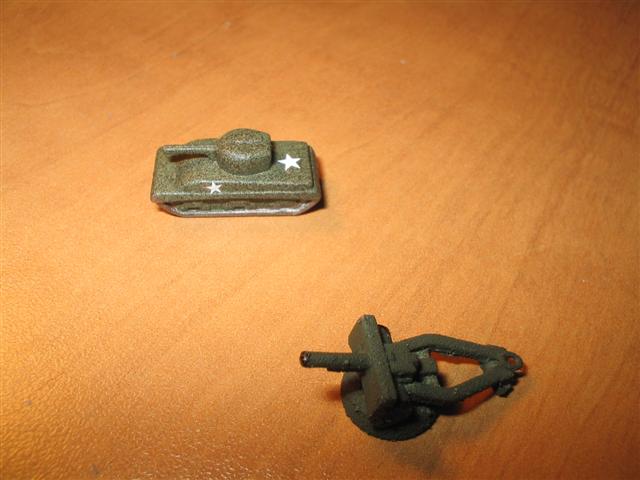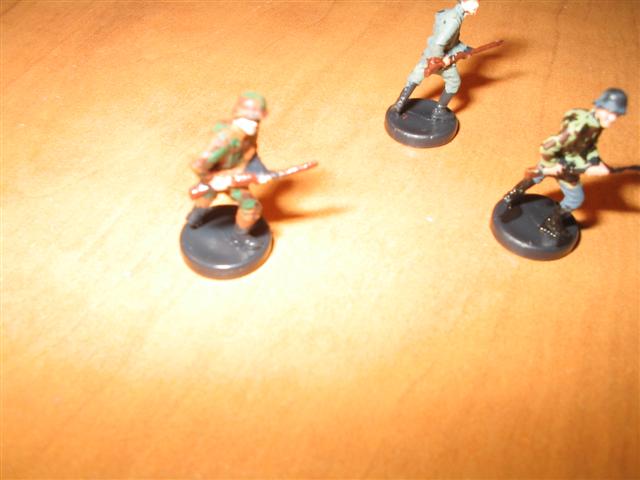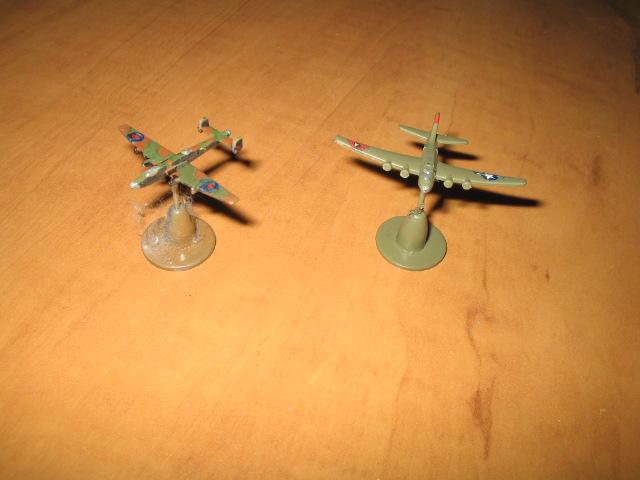@dinosaur:
One note you will see if you look closely at the photos. The paint is fairly soft, and the molding process leaves a finish that is not best for the paint. The paint has started to come off on the corners a bit. It isn’t a big deal but keep that in mind. I suspect there is someone out there that may know a pretreatment that would help the paint adhere to the soldiers even better.
Thanks for sharing your labor of love Dinosaur. Great work. I’d never painted plastics before either, so it took some research and some dabbling… here is one of the best articles I found that sums it up.
http://www.boardgamegeek.com/thread/183861
– article – (and to whoever wrote this… thank you!)
I’ll copy here the same thing I always post about painting the plastic men up for our Descent game, since we use the same technique for any plastic gaming miniatures we paint up.
Just insert the word “T.O.I” or “Memoir '44” for “Descent”. Indeed, someday I have to get around to painting those up, too!
////////////
My wife generally does our miniatures painting (she is really quite good), but for our Descent game we went with a tried-and-true, newbie-friendly method so that I could give her a hand, and still get nice results.
Plus, we’re cheap, old-school gamers. We don’t like to pay money if we don’t have to.
Step One: Primer
Use White automobile primer, no-name brands from low-cost stores like WalMart, etc. Coat lightly, but evenly. The masters don’t have to be pure white (they’ll wind up looking kinda pink-ish). Don’t worry. You just want enough primer for the other paint to stick to.
Step Two: The Paints
Use acrylic craft paints, like “Apple Barrel” paints, from low-cost stores like Walmart, etc. Don’t buy them at craft stores, or you’ll spend too much. Each tube of paint runs about 50 cents, and ours have lasted years and years. However, for metallics (like for chainmail, bronze, etc.) we still find that the standard miniatures paints are a little nicer.
Step Three: The “Dip”
For Descent miniatures, we opted to go for the “Dip” method, or “Magic Dip”, as it is sometimes called.
What is this magic dip, you ask?
Minwax light- or medium-brown wood stain. Yes, wood stain. I know, it sounds crazy! A little can, costs about 2 dollars, lasts for years of projects.
Some people actually “dip” their entire miniature in the stain, then wick off the excess. I find that a bit much, so instead we just paint it on with a brush.
The Dip Method:
a. When painting, paint broad general colours over things, but paint them in lighter tones than you normally would. So paint the beastman skin a light flesh tone, paint his loincloth a light red, leave his hair primed white, paint his sandals light brown. He looks cartoonish and ugly so far, with just general bright colours, and no details.
b. Brush on Minwax wood stain. Light/medium Brown colours work well, because they don’t darken the original paint too much. IF you want more black colours, make it a very light grey/black, or you’ll just stain the whole thing black.
The stain flows over everything, but then runs into the cracks by preference. It acts similarly to an ink wash, but with slightly different (and useful) results.
The wood stain tones down the colours (that’s why you painted them lighter than you would’ve normally), blends them, blurs the edges between each broad colour band. It also fills in the cracks with dark colour, making the details POP out instantly. Finally, it coats the miniature with a nice protective coating.
It really does blend the colours together. Our Hellhounds were painted with broad bands of 3 shades of brown, then stained, and suddenly they looked all blended and shaded, but with the cracks filled in an the manes completely detailed out. It is truly nifty to watch!
If too much stain has pooled in one spot, use a small piece of paper towel to wick off the excess easily. Check the miniature every few minutes, to see that you’re getting the results you want.
Let the stain dry completely, until it is no longer tacky. This can take a full 24 hours for some miniatures, but we’ve managed to paint miniatures just an hour or so after staining.
c. Now, go back and drybrush on a few last details. Drybrush teeth white (but leave those cracks filled in brown/black, so the details still stand out nicely). Drybrush chainmail with a nice metallic silver. And so on. Just pop out those last few details that you want to call attention to.
d. Clear-coat with a dull/matte acrylic clear coat protector. This will stop the paint from chipping through extended use.
/////////////
“The Dip” is fast, simple, easy, and gets results! I can’t paint a miniature to save my life, but I’ve managed to paint up my descent miniatures quite nicely. Of course, for truly nice work, I hand them over to my wife for detailing. However, for the general monstrous-type miniatures, when I just want to paint them quickly-yet-prettily, this method can’t be beat.
“Magic Wash” method (an alternative to “the dip”)
Another method is to use “Magic Wash”, which is a mixture of 4 parts water to one part “Miracle Floor Wax”, then mixed with paint. This forms a paint wash, which you can use instead of “the dip”, but with a similar sort of aim. You can customize the hue, tint, and colour to your heart’s content, wash it over your figure, and it’ll seep into the cracks. Make your Wash colour nice and dark (darker than what you’re painting), and it’ll also harden up ever so slightly when it dries (that’s the plastic wax component of the Miracle Floor Wax) to form a mild protective coating on your miniature.
Either method is quick and easy and cheap.










